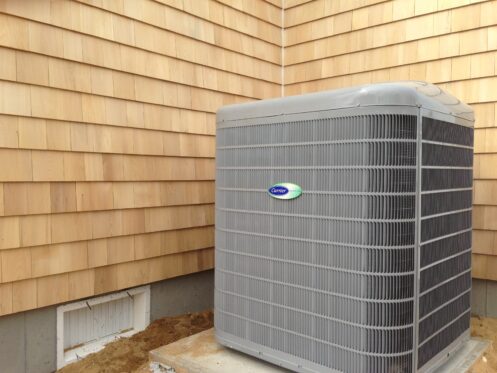When in the market for a new air conditioner, one of the most important things to focus on is energy efficiency. Choosing an efficient air conditioner is important for helping keep your electricity bills lower and also reducing the environmental impact that comes from cooling your home. SEER ratings tell you how efficient any air conditioner is, but the problem is that they can be difficult to understand. That’s why we’ve produced this guide that will explain SEER ratings in detail and show you how to use them to determine which AC is the best choice.
An Overview of SEER Ratings and What Exactly They Mean
SEER stands for Seasonal Energy Efficiency Ratio and is a metric used to express the energy efficiency of most air conditioning systems including traditional central ACs, heat pumps and ductless mini-split ACs. Calculating the energy efficiency of these types of air conditioners is difficult since the main part of the system is outside where it is often subjected to extreme heat and humidity. High temperatures and humidity make air conditioning less effective and result in the system needing to work harder, which in turn leads to a decrease in its efficiency.
The fact that the energy efficiency of an air conditioning system fluctuates as the temperature and humidity level change makes it impossible to just look at how efficiently a system works at one specific time. Instead, the only way to accurately judge the overall efficiency is by taking an average over an entire cooling season, which is exactly what SEER ratings do.
Before the rating can be calculated, the system first must be tested by running it in the various conditions it is likely to operate in throughout a cooling season lasting from late spring to early fall. This provides information on the total BTUs of heat the system can remove and the total kilowatt-hours of electricity it would use in an average season. The SEER rating can then finally be calculated by dividing the heat the system removes by the amount of electricity it consumes. The higher this ratio is, the more efficiently the system works.
Understanding SEER2 Ratings
To make matters even more confusing, the US Department of Energy got rid of the original SEER ratings in 2023 and replaced them with the updated SEER2 rating scale. SEER2 ratings are still a ratio of heat removed to energy used just like the original SEER ratings. The only difference between the two is that SEER2 uses slightly different testing parameters that are meant to be a more accurate representation of real-world operating conditions. Specifically, the SEER2 tests are run at a higher static pressure, which refers to the amount of airflow resistance there is in the system. Most HVAC systems have issues with slightly higher static pressure due to issues like dirty air filters and ductwork leaks, and the SEER2 tests are designed to account for this to provide more accurate results.
It’s not really an issue if you don’t fully understand the differences between the two ratings since most systems will still list both the SEER and SEER2 ratings. There are also numerous calculators available online that will automatically convert between the two if you’re unsure.
How to Use SEER Ratings to Compare Different AC Systems
The main purpose of SEER ratings is to allow consumers to compare different air conditioners and also estimate approximately how much energy any AC would typically use in a season. In this way, you can then calculate approximately how much less energy a system with a higher SEER rating would use compared to a more basic system.
The Department of Energy mandates minimum energy efficiency requirements for all new air conditioning systems. In Idaho and the rest of the northern US, the current minimum is 14 SEER or 13.4 SEER2. Each additional SEER value above this equals just over a 7% increase in energy efficiency. In other words, a 15 SEER (14.3 SEER2) system would use approximately 7% less electricity than a 14 SEER system. In Bountiful and the Salt Lake City area, a 7% increase in efficiency would typically reduce your air conditioning costs by somewhere around $20 to $40 per year. If you opted for a 20 SEER system instead, it would likely save you between $70 and $140 a year compared to a 14 SEER system. Of course, these numbers are merely averages and your actual savings may vary depending on the size of your AC and how well insulated your home is.
If you have a much older air conditioner that was installed before 2006, even upgrading to a 14 SEER unit could save you lots of money. Up until this point, the minimum efficiency requirement was only 10 SEER. If your current unit is only 10 SEER, a new 14 SEER unit should reduce your energy costs by at least 28%. Your savings will most likely be even greater since the energy efficiency of AC systems tends to decrease quite a bit the older they get.
The most efficient central air conditioners currently available are up to 28 SEER, but it doesn’t always make sense to go with the most efficient unit you can find unless you’re on an unlimited budget. As you’d expect, high SEER units are far more costly. Even though a high SEER unit will save you money on your energy bills, the savings may not ever come close to outweighing the much higher upfront cost. For this reason, it’s always a good idea to look at both upfront costs and estimated energy savings when determining which AC is the best choice.
When choosing a new AC, the first thing you need to do is determine your estimated budget so that you can then start comparing different ACs in your price range. This allows you to then estimate approximate energy savings over the average 15-year life of an AC system and compare it to the upfront costs of different SEER systems. If the energy savings are greater or come close to balancing out the additional upfront cost, you should definitely go with the more efficient, higher SEER system.
For instance, let’s say that you need a 3-ton AC and you want to compare a 14 SEER and 20 SEER system. The 20 SEER system would use approximately $100 a year less in electricity and potentially save you around $1,500 over its typical 15-year lifespan. Knowing this, you can then determine whether the 20 SEER system is worth the extra upfront cost or if you’d be better off choosing a slightly less efficient system.
Blue Best Plumbing, Heating, Air, & Generators has more than 20 years of experience providing expert air conditioning services to customers in Bountiful and the Salt Lake City area. If you’re in need of AC installation, our team can explain all of the available options and help you determine which system will meet your needs most efficiently. We can also take care of your maintenance and repair needs to ensure your AC keeps functioning efficiently and lasts as long as possible, and we specialize in professional heating and plumbing services as well. Give us a call today if you have any questions or to schedule a consultation or service call.








